DIY PVC window installation
When planning to replace old windows with new ones, many are wondering how difficult it is to install them yourself. The answer is medium difficulty work. In terms of time, replacing a medium-sized window with dismantling the old one takes about 3.5-4.5 hours. This is for a person with no experience. Employees of firms who do this all the time spend less than an hour on it. But the installation of plastic windows by the owner of the premises with his own hands cannot be compared with the hasty work of "professionals". They simplify the process to the point of indecency, arguing that prices have not been raised for 6 years and they have no time to waste time on trifles. If you are lucky enough to find really masters, then you can entrust them with the installation. If not, take the weekend and install it yourself.
The content of the article
Construction of plastic windows
To properly understand the installation process, you need to have an idea of the construction of windows. Let's start with materials and titles. Plastic windows are made of polyvinyl chloride, which is abbreviated as PVC. Hence the second name is PVC windows.
The main element of any window is the frame. For plastic windows, the frame is made of a special multi-chamber profile. It is divided by partitions into a number of cells - chambers. The more of these cells, the warmer the window will be. When they talk about how many cameras there will be in a plastic window, they have the number of cells in the profile.

Windows from the same manufacturer with a different number of cameras in the profile
In the middle of the structure, in the largest chamber, a blue insert is visible. This is a reinforcing element of increased rigidity. It gives the profile the required strength. In plastic windows this insert is made of plastic, in metal-plastic windows it is made of metal (usually aluminum). That's the whole difference between them.
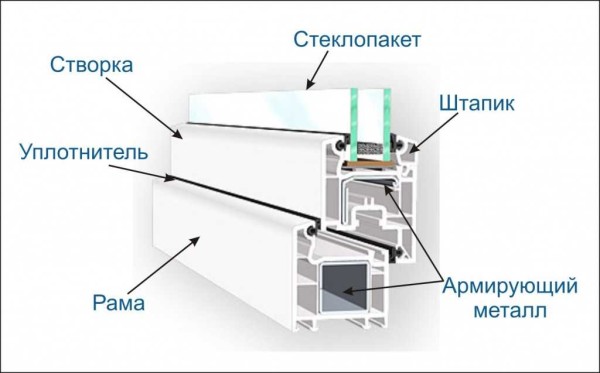
The structure of a metal-plastic window
There is also a division of profiles into classes: economy, standard and premium. The best choice if you need normal windows is the standard class. In the economy class, partitions are too thin and they begin to freeze almost from the moment of installation. The premium has a high price tag due to options that, in fact, are not needed.
If you want to have the best profile for plastic windows, take the class standard of any factory. There is no particular difference between the products of different companies. They have been standardized for a long time and all the stories of managers about the benefits are fairy tales. If they are made on factory equipment, there is no difference between them: all factory profiles have long been standardized.
Window profiles are white as standard, but they can also be brown - to match the color of any tree, and even pink - on request. Colored profile windows are more expensive than similar white ones.
Window structure
To understand what is at stake in the description of the installation process, you need to know what each component of the structure is called.
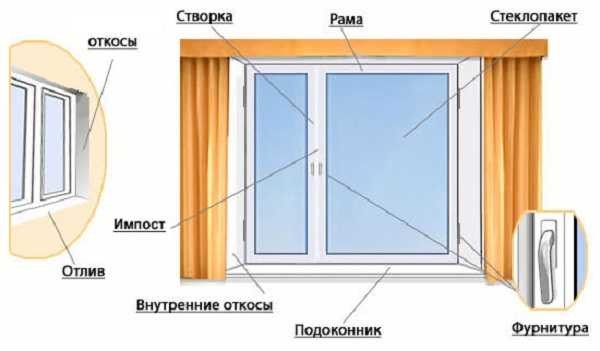
What does a plastic window consist of?
It consists of:
- Frames. This is the base of the window.
- If the window consists of several parts, the frame is divided into parts by an impost - a vertical component. If the window is of two parts, there is one impost, If of three - two, etc.
- The opening part of the window is called a sash, the fixed part is called a capercaillie. A double-glazed window is inserted into them - two, three or more glasses, hermetically fastened to each other. A foil tape is laid between the glasses, which ensures tightness. There are double-glazed windows with special properties: with reinforced glass, tinted and energy efficient, which, according to manufacturers, reduces heat loss through windows. There are also double-glazed windows, between the glasses of which an inert gas is pumped. It also reduces heat loss.
- Double-glazed windows are pressed against the frame with a cap - a thin plastic strip. The tightness of the connection is ensured by a rubber seal (it is usually black).
- Locking fittings are installed on the sashes. This is a specific set of mechanisms that provide opening and closing. They can be different, as they provide different functionality: opening, opening with ventilation, opening + ventilation + micro-ventilation.
- To ensure tightness on all parts - frame, impost and sash - rubber seals are installed.
At the bottom on the outside of the frame (the one that faces the street) there are drainage holes that are covered with special caps. Through them, condensation is discharged into the street, which forms inside due to the temperature difference between the street and the room.
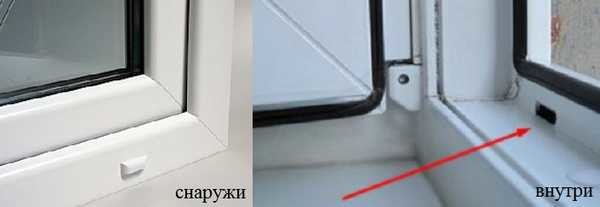
Drainage holes
The window also has an ebb - a board outside that removes precipitation and a window sill inside. Side and top parts from the street and premises covered with slopes... They can also be made of plastic or made using another technology.
Read here how to adjust the PVC window.
How to measure a plastic window
When ordering windows, you will be asked for six sizes: the height and width of the window, the length and width of the window sill and the slope. In order to measure everything correctly, it is necessary to determine whether you have made a window opening with a quarter or without.
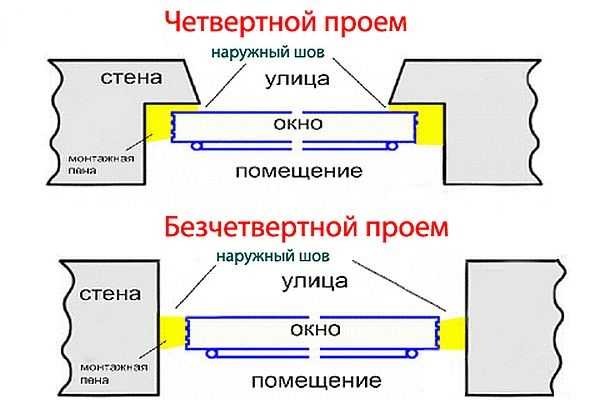
Opening with a quarter (quarter) and without
Examine the opening. If the outside of the window is narrower, the opening is a quarter. In this case, measurements are taken at the narrowest place: openings rarely have ideal geometry, therefore, they will have to be measured at several points. Find the smallest value, add 3 cm to it. Transfer the height as it is.
If the opening is even, the calculation is different. Measure the width and height. Subtract 3 cm from the measured width, 5 cm from the height. This will be the height and width of your window. We remove 3 cm in width, since a gap of at least 1.5 cm is required on both sides for the mounting foam. We subtract 5 cm in height, since the same 1.5 cm is needed from above, and 3.5 cm from the bottom will be spent on installing the window sill.
The length of the window sill and low tide is taken with a margin - 5-10 cm more than the width of the window opening. During installation, both the low tide and the window sill "sink" a little into the adjacent walls, and the excess will go there. The ebb tides are standard in width, so the nearest larger one is chosen. On the windowsills, the situation is different. Its width is chosen arbitrarily - at the request of the owner. Someone likes wide ones - so that you can put something, someone prefers flush with the wall. So there are no rules.
Even when ordering, you will need to indicate how many and which parts will be in your window: whether or not the capercaillie is, where it is located, how many doors, which side they are, how they should open. You will need to specify the type of fittings (ventilation, micro-ventilation).
Preparation
If you change the windows, installing plastic windows with your own hands begins with dismantling the old one. Usually there are no problems: breaking, not building. After dismantling, it is necessary to revise the opening: remove everything that can fall off. If there are any protruding parts, they must be removed - with a hammer, chisel or power tool. When the plane is leveled, all construction debris must be removed. Ideally - sweep out everything, even dust, otherwise, during installation, the foam is difficult to "grab" with the wall.

Preparing the opening for installation
If there are too large potholes or cavities, it is better to cover them with cement mortar. The smoother the opening, the easier the installation will be. With a loose material of the walls, they can be treated with binders: penetrating adhesive primers.
How to install correctly: choosing an installation method
There are two different techniques: with and without unpacking (disassembling) the window. When unpacking, holes are drilled through the frame, through them an anchor is driven into the wall. This method is more complicated, but the fastening is more reliable.
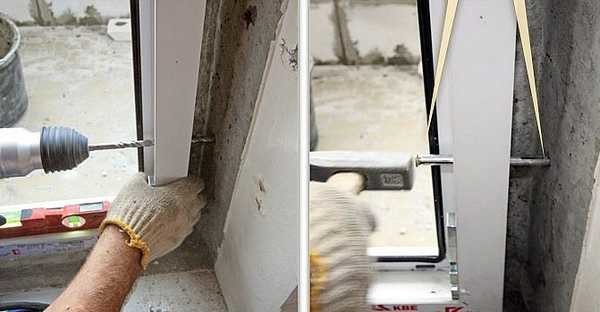
This is an anchor bolt installation. They are put three pieces on each side.
When installing without unpacking, metal plates are attached to the frame from the outside, and then to the walls. This, of course, is faster, but the fastening is very unreliable: with significant wind loads, the frame will warp or it will sag.
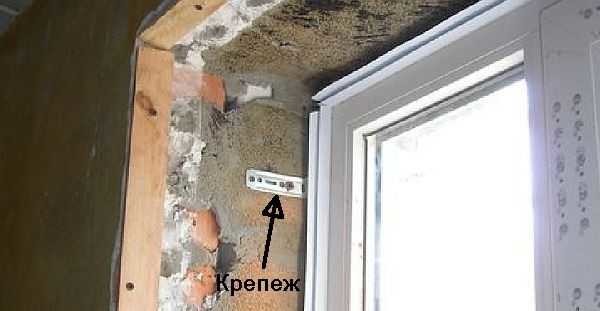
These are the fasteners most commonly used by installers. How, in my opinion, they look unconvincing
If you really don't want to disassemble the window, you can also mount it on a plate, but not narrow and thin, but thick and wide, which are still often used when installing a rafter system.
In principle, small windows mounted on mounting plates, provided there are no significant wind loads, can stand normally. If you live in a region with strong winds, and they blow mainly through your windows, if the apartment is located in a high-rise building on a high floor, then installation with unpacking is necessary.
Below you can see an emotional and easy-to-understand video, which explains why it is better to use anchors.
The installation of a mosquito net is described in this article.
DIY installation of plastic windows: step by step instructions
Let's describe both methods: suddenly you need a method with mounting on plates. It is used in buildings made of foam blocks, the bearing capacity of which is low and the load from the windows has to be distributed over a large surface. This method of installing plastic windows is also necessary if the building is built using “layered” technology. For example, there is concrete in front and behind, and between them a layer of insulation. If the window should stand exactly in a soft layer, then it will need to be fixed with plates. Installation of PVC windows in brick, cinder block, panel, etc. house is desirable for anchor.
Installation with unpacking
Do-it-yourself installation of plastic windows begins with measurements. Measure the frame and window opening, make sure they are compatible. Then you can get to work. The process begins with disassembling (unpacking) the PVC window. Here are the steps:
-
-
-
- Remove the window sash:
- Close the window (handle is turned down).
- Remove the plastic covers on both hinges. They pry off with a screwdriver.
- There is a pin on the top hinge that provides a movable connection. It is in the center and protrudes slightly. Press on him until he drowns (you can take a metal plate, rest it on the pin and lightly tap on the plate). The pin will slide out from below. It can now be grasped with side cutters or pliers and pulled downwards to remove.
- Holding the sash at the top, open the lock. To do this, put the handle in a horizontal position. Tilting the upper part towards you slightly, lift the sash, removing it from the lower pin.
The entire sash is removed. To make it clearer, watch the video. It describes in detail how to remove and install the sash on a plastic window.
- On capercaillie, remove the glass unit. It is supported by glazing beads. They must be removed, then the glass unit itself will be removed without problems. They remove the glazing beads like this:
- Something narrow and strong is inserted into the gap between the glazing bead and the frame. If no special tool is available, it is best to use a small spatula. Disassembly begins on one of the long sides.
- The spatula is carefully driven into the slot with a corner and gradually move the glazing bead away from the frame.
- Without removing the tool, they move along a little, again pushing the glazing bead aside.
- So they go along the entire length. As a result, the glazing bead is almost separated, it is simply taken out.
- With the short side, everything is easier: the freed edge is pushed on and, by turning the spatula, removed from the groove. Grab the free edge with your hand and pull up.
Now you can try to remove the glass unit. Just be careful: it's heavy. If it does not work, remove another of the glazing beads. Just make sure that the window is inclined and the glass unit does not fall out. Now, if necessary, you can independently replace the glass unit. Watch a video on how to remove glazing beads from PVC windows.
- Remove the window sash:
- The freed frame along the outer perimeter is pasted over with a special self-adhesive tape. Its installation is recommended by GOST.With her, the window is not so cold.
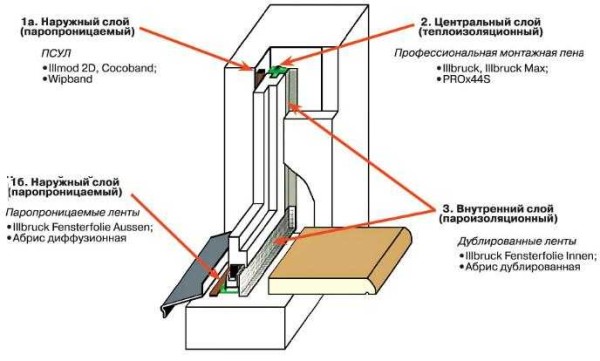
Where to glue the tapes when preparing a plastic window for installation
- Remove the campaign logo tape. If left, it will melt too much with the frame under the influence of the sun and it will be problematic to remove it.
- The prepared frame is inserted into the window opening. Mounting wedges are used to position it. They must be installed in the corners and under the impost. The rest are arranged as needed. By placing them, the window is set strictly level in three planes. Pre-fix the position of the window. This is where you can use the mounting plates.
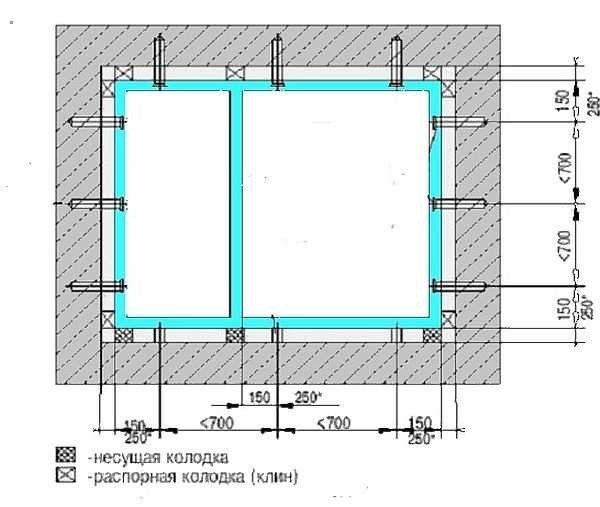
Arrangement of mounting wedges and distance between fasteners
- Take a drill and drill, which is the same size as the diameter of the anchors. Make holes for fasteners. 150-180 mm recede from the upper edge. This is the first hole. The bottom is about the same distance from the bottom corner. Another anchor is installed between them in a standard window: the maximum distance between two fasteners should not be more than 700 mm.
- Having made a hole, check if the frame has moved (level in all three planes), then hammer in the anchor and tighten it. You cannot drag: the profile should not bend. This operation is repeated as many times as necessary.
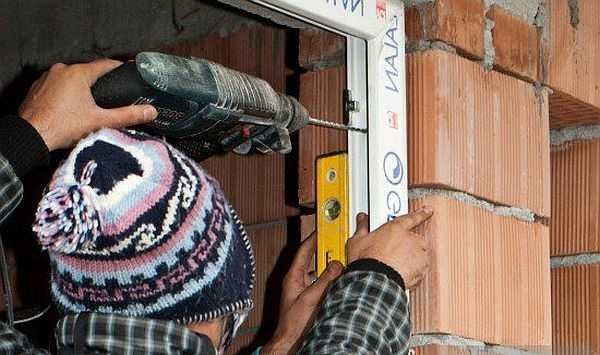
You need to constantly check the correctness of the installation.
- Install ebb tides outside. To do this, first, a vapor-permeable waterproofing (it is self-adhesive) is glued to the outer part of the frame. Small grooves are made on the sides of the window opening, into which the edges of the ebb tides are then brought in.
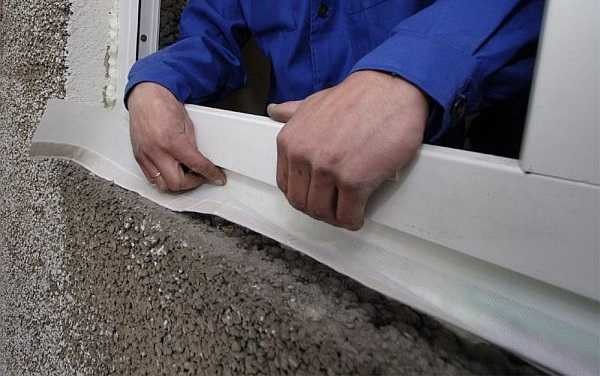
Installation of waterproofing tape under the ebb of a plastic window
- A layer of foam is applied to the part of the window opening from the outside, where the ebb will rest on the wall. Sometimes, if the height difference is large, a lining profile is installed here. and then olive is attached to it. The cut-to-size ebb is brought under the frame ledge and there it is attached to the frame with self-tapping screws.
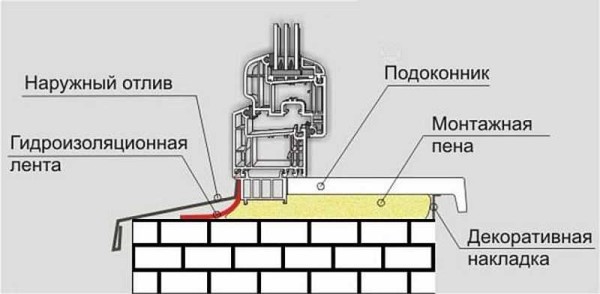
How to install an ebb and sill on a plastic window
- The low tide also foams along the bottom edge.
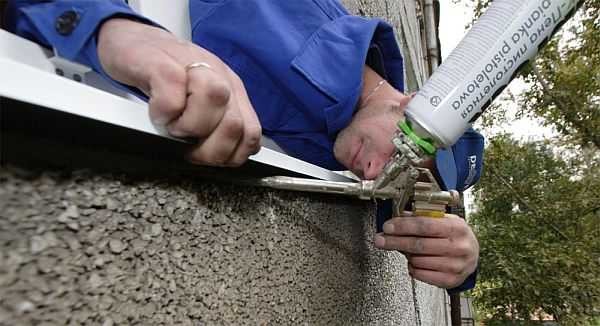
Foaming low tide from below
- Next, the opening is foamed. When installing plastic windows in summer, the gap between the frame and the window opening is sprayed with water from a spray bottle. This is necessary for better foam polymerization.
- A vapor-permeable heat-insulating strip is glued along the frame contour - it is also recommended by GOST.
- Take a balloon with foam and fill the existing gaps by 2/3 of the volume. If the size of the gap is large - more than 2-3 cm - foam is applied in several stages. A time interval of 10-15 minutes is required between the two layers. When the first layer is partially dry, it is also sprayed with water and the second is applied. This is repeated until the volume is filled by 2/3.
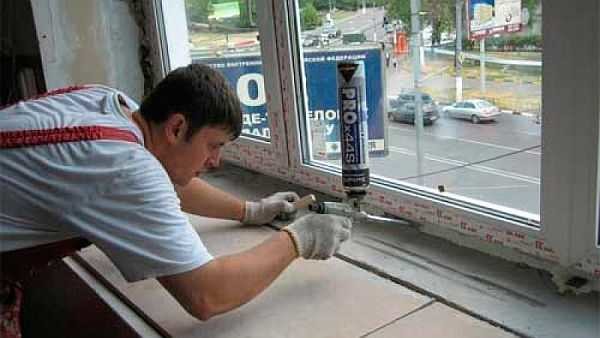
Foaming PVC windows during DIY installation can be carried out in several stages - it depends on the size of the gap
- Without waiting for complete polymerization, the free edge of the heat-insulating tape is glued to the window opening. Just note that when using tape, the slopes will need to be made of plastic: plaster and mortar do not "stick" to it.
- Collect all the pieces of the window. Only finishing work remains, and they are not a hindrance to them.
- A vapor barrier tape is also installed under the window sill in the lower part (also GOST recommendations). The window sill rests on support blocks made of hard grades of treated wood. The distance between them is 40-50 cm. They are made in such a way that the window sill is slightly inclined towards the room (about 5 °).
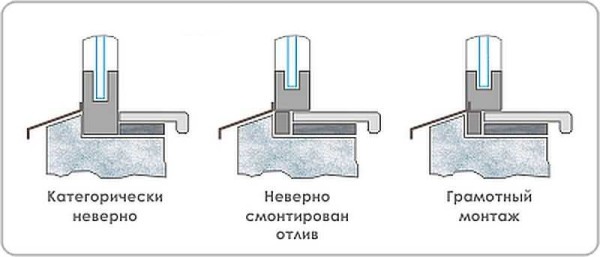
Errors when setting the window sill and slopes of PVC windows and their correct installation
-
-
Watch the video on how to properly position the window sill when installing a plastic window. There are many secrets.
Slopes are installed or sealed last. On this occasion, another video.
Read here how to make slopes on a plastic window. How to do plasterboard slopes read here.
Installation without unpacking
The main points are described above, so this chapter is short. The installation for this option begins with the installation of the mounting plates.They are of two types: U-shaped and linear. It is important to choose the most reliable thick metal.
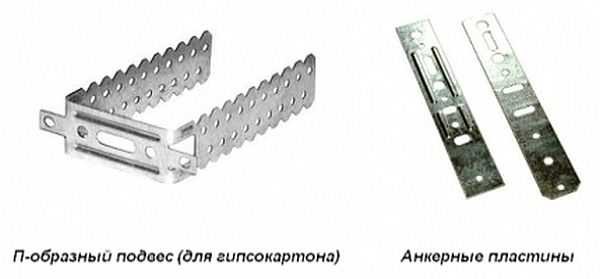
Two types of plates for mounting plastic windows
They are installed at the same distance as the anchor: 150-250 mm from the edge and no more than 700 mm between the middle ones. They are simply screwed to the profile with self-tapping screws.
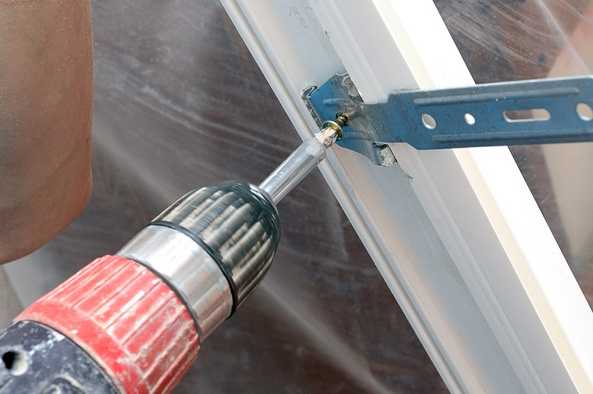
Fastening the plate to the profile
Then, the installation of plastic windows with your own hands with mounting plates is identical to that described above, starting from the moment the window is level in the opening. Only they do not attach the frame, but the plates and not to the anchor, but to the dowel-nails. A hole is drilled, the plate is folded back, the dowel is inserted, putting the plate in place, the dowel is twisted. Further, all actions are identical.
Now it is clear why installers prefer them: it takes a decent piece of work with disassembly, anchoring, etc .: screws are much easier to tighten. True, if you take powerful plates, they will hold tight. No worse than an anchor. For example, such as in the video.

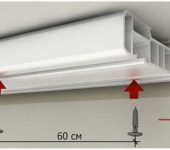

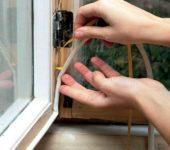
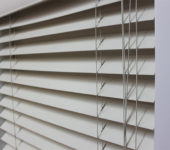
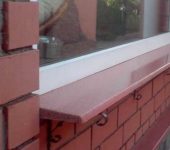





And if the double-glazed window is damaged for some reason, are there ways to replace or repair it?
Of course there is, but there are a number of subtleties when replacing it ...
Therefore, it seems that it was damaged, because I read a lot of stupid articles like this one and saw enough idiotic videos from Zemskov. Frame anchors violate the integrity of the profile chambers with all the ensuing consequences (literally and figuratively), complicate the alignment of the window in the inward-outward plane. And after installation, the window in the opening holds the assembly seam, and not the anchor or plate.
And by the way, installers never put windows on plates without unpacking. Think about it.
Ivan Ivanov.
The assembly seam has NEVER served as a frame fastener. And by the way, think about the integrity of the glass unit in the light of the presence of holes for condensate drainage.
I am sure that how long they will serve you depends by 50% on how you install the windows ... Therefore, I would still trust this question to professionals. I studied the issue for a very long time so that the installers were experienced, so that everything was OK with the certificates. As a result, windows from kve 76 were installed a couple of years ago. We were completely satisfied with the installation ... and the windows themselves showed themselves on a good side: the house is warm, no noise, we were very pleased with the purchase)
1) if you do not live in the steppe on the 12th floor, then it doesn't matter what to fix it on.
2) the anchor should be 3-4 mm, not thinner, otherwise it is better on the plate
3) attach to the plate, it's easier for beginners (and we are talking about this)
4) the wedges knock and fall out during the installation process. You need to think about fixing them.
5) it is impossible to clamp the frame strongly, the glass unit may not fit back.
6) if the walls are made of wood, then the wedges can also be made of wood. They will last no less than the walls themselves.
7) God forbid you to pull the glass unit out of the opening sash! You can put the bald devil back in him later! It stands there on the wedges, and when installed in a vertical position, all these wedges fall out! There are no such difficulties with deaf spikes.
8) the drywall plate does not fit, because it must fit into the groove on the binding and press tightly against it.
9) glazing beads are hammered back with a hammer through a block
10) it is better to remove the film after filling the assembly seam - the frame will be cleaner.
> 7) God forbid you to pull the glass unit out of the opening sash! You can put the bald devil back in him later! It stands there on the wedges, and when installed in a vertical position, all these wedges fall out! There are no such difficulties with deaf spikes.
Why, if you can remove the sash?